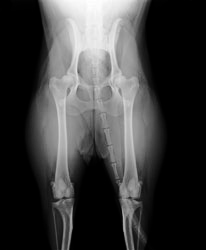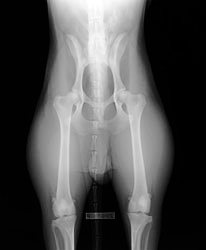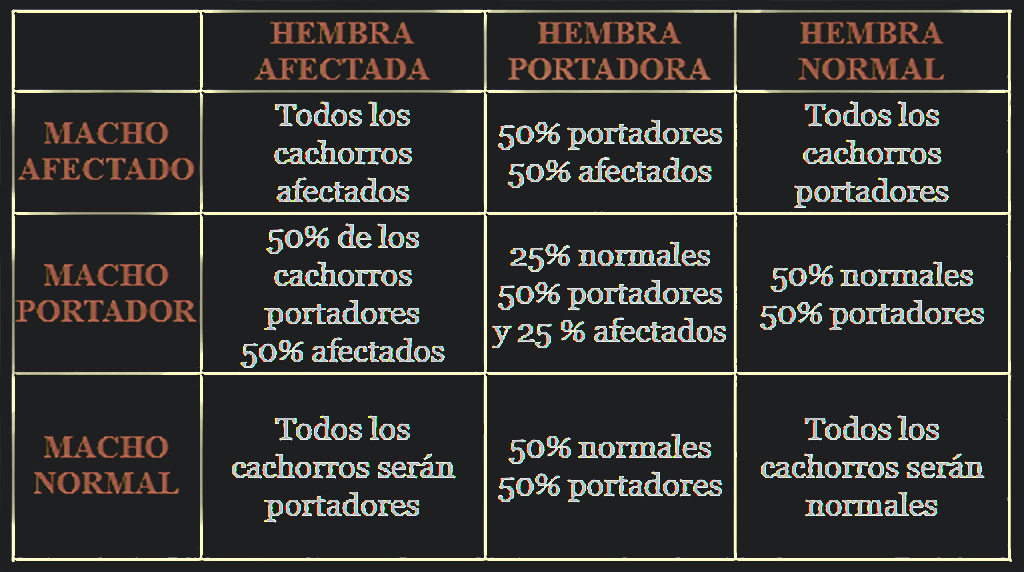Enfermedades del Border Collie
En Bleu Perle Border Collie velamos porque nuestros perros estén libres de enfermedades y que críen cachorros sanos,
por lo que les realizamos las pruebas necesarias para ello.
DISPLASIA DE CADERA (DC)
QUE ES LA DISPLASI DE CADERA Y CAUSAS DEL PROBLEMA
La displasia de cadera consiste en un desarrollo defectuoso de la articulación de la cadera y el fémur (articulación coxofemoral) y un proceso degenerativo de la misma. La displasia es una enfermedad multifactorial. Presenta un fuerte componente genético, con un índice de heredabilidad muy alto, así como una serie de factores medioambientales, nutricionales o de conducta en general que actúan favoreciendo o evitando su aparición. En todos estos factores parecen estar claramente demostrados el exceso de actividad de los cachorros, los alojamientos con pisos resbaladizos o las dietas que favorecen un crecimiento demasiado rápido de los cachorros.
Es fundamental el cuidado de la alimentación de forma que el pienso que se suministre al cachorro esté perfectamente equilibrado tanto en energía como en minerales y vitaminas permitiendo que, en estos animales de crecimiento rápido, se compense el crecimiento de los huesos y el de los tejidos blandos, sobre todo la musculatura.
Recordemos que unos malos hábitos con nuestro cachorro puede causar problemas y que debemos evitar ejercicios como saltos peligrosos, subir y bajar escalones en exceso, resbalones… etc. El animal racional a la hora de trabajar con nuestros perros somos nosotros. Debemos saber controlar y dosificar a nuestro joven compañero. Por mucha energía y capacidad que muestre el cachorro para correr, saltar, subir y bajar… esta actividad que a nuestro pequeño tanto le divierte puede ser perjudicial para su salud, si no lo controlamos adecuadamente.
SÍNTOMAS
Cuando un perro tiene displasia, las articulaciones se desarrollan de forma defectuosa. La cabeza del fémur no encaja de forma correcta en el acetábulo o cavidad de la cadera. De este modo la cadera es inestable y produce inflamación, debilidad y dolor.
Los síntomas pueden ser engañosos, ya que en algunos casos el animal no da muestras de ello hasta que el problema está ya en una fase muy avanzada. En los casos en los que se manifiesta se pueden observar desde pequeñas anomalías en el movimiento al caminar del perro hasta cojeras graves, llegando incluso a evitar apoyar alguna de las extremidades. Aunque estos síntomas pueden indicar la existencia de esta enfermedad la única forma verdaderamente fiable de detectarla es mediante radiografía.
DIAGNOSIS
En la actualidad no tenemos ningún método genético que nos muestre que individuos son propensos a la enfermedad, por lo que el único método de control es la radiología. De este modo controlando los ejemplares reproductores, sabemos que de individuos con buenas caderas obtendremos descendientes casi con toda probabilidad libres de displasia.
Las radiografías deben realizarse en un centro veterinario y generalmente con el animal bajo anestesia general, ya que con el perro despierto no es fácil obtener las radiografías porque la posición les resulta incómoda.
A los criadores, la radiología nos permite establecer un programa de selección y no utilizar como reproductores aquellos animales que no se consideran aptos según su grado de displasia. Como criadores es nuestro deber informar adecuadamente a los futuros dueños de nuestros cachorros del estado de los progenitores y recomendar las medidas más adecuadas a adoptar con el cachorro. Un buen consejo puede evitar problemas graves.
Ejemplo de una cadera afecta de displasia, así como de los sucesivos tratamientos aplicados para rectificar la posición anómala de los huesos, tras diversas intervenciones quirúrjicas. Como se puede apreciar, se trata de un tratamiento invasivo, costoso y que implica la anestesia del animal. Fotos cedidas por Marie-Pierre, Moselle (Francia), de su perro tricolor. -G (gauche, izquierda) y D (droite, derecha)-.

Radiografía de la cadera, libre de displasia, de una de nuestras hembras
«En Bleu Perle Border Collie velamos por que nuestros perros estén libres de enfermedades y que críen cachorros sanos, por lo que les realizamos las pruebas necesarias para ello».

Placa de la cadera de uno de nuestros machos, donde puede apreciarse que no hay deformaciones ni crecimiento anómalo de los huesos.
LIPOFUSCINOSIS CEROIDE NEURONAL (CL)
La lipofuscinosis ceroide neuronal (CL) se produce por un tipo de epilepsia que causa la acumulación de lipopigmentos auto-fluorescentes en las células cerebrales produciendo la degeneración de las mismas y de las células oculares, mostrando los individuos afectados los primeros síntomas al año de edad, tales como la pérdida de capacidad motora, falta de visión, etc.
La CL es en la gran mayoría de los casos es una enfermedad letal, ya que no existe tratamiento alguno de cura. Actualmente se dispone de pruebas genéticas que indican si un perro es normal, portador o afectado, pudiendo de esta manera optimizar los cruces para no perder excelentes genéticas y a su vez no producir, en ningún caso, cachorros afectados. Teniendo en cuenta la genética, los ejemplares pueden ser:
– NORMALES:
Los individuos normales nunca padecerán la enfermedad ni la trasmitirán a sus descendientes.
– PORTADORES:
Los individuos portadores nunca padecerán la enfermedad. Un ejemplar portador sólo se debería cruzar con otro libre. De este modo ninguno de sus descendientes padecerá la enfermedad.
– AFECTADO:
Los ejemplares afectados tienen la mutación genética y se espera que a lo largo de su vida desarrollen la enfermedad, de manera más o menos severa. Estos ejemplares sólo se deberían cruzar, en su caso, con individuos normales. De este modo ninguno de sus descendientes padecerá la enfermedad.
TABLA DE RESULTADO EN LOS CRUCES SEGÚN SU CÓDIGO GENÉTICO
En esta tabla vemos los distintos resultados que se obtendrían en cada uno de los cruces posibles según los resultados mediante pruebas de ADN. Es importante reseñar que siempre se debe evitar cruzar individuos que pudiesen dar cachorros afectados.

ANOMALÍA DEL OJO DEL COLLIE (CEA)
La Anomalía del Ojo del Collie (CEA) es una alteración congénita de carácter hereditario que afecta a la túnica posterior fibrosa y vascular del ojo. Es también conocida como Síndrome de Ectasia Escleral. Se considera que la patogenia se basa en una diferenciación mesodérmica anormal que desencadena defectos de variable importancia
Los síntomas en que se basa el diagnóstico son su presentación congénita, su carácter hereditario recesivo, el hecho de que la visión se ve afectada en pocos casos y puede afectar a la esclerótica, coroides, retina y cabeza del nervio óptico.
El diagnóstico es dificíl, en la medida en que se manifiesta en cuatro tipos de lesiones, cuya presentación es por tanto variable, y por su carácter recesivo. Sin embargo, es posible realizar el diagnóstico sobre las 6 ó 7 semanas, lo que favorece el necesario control de la enfermedad. A mayor edad, mayor dificultad para realizar el diagnóstico.
Actualmente se dispone de pruebas genéticas que indican si un perro es normal, portador o afectado, de forma que se pueda optar por los mejores cruces y no producir en ningún caso perros afectados.
– NORMALES:
Los individuos normales nunca padecerán la enfermedad ni la trasmitirán a sus descendientes.
– PORTADORES:
Los individuos portadores nunca padecerán la enfermedad. Un ejemplar portador sólo se debería cruzar con otro libre. De este modo ninguno de sus descendientes padecerá la enfermedad.
– AFECTADO:
Los ejemplares afectados tienen la mutación genética y se espera que a lo largo de su vida desarrollen la enfermedad, de manera más o menos severa. Estos ejemplares sólo se deberían cruzar, en su caso, con individuos normales. De este modo ninguno de sus descendientes padecerá la enfermedad.

TRAPPED NEUTROPHIL SYNDROME (TNS)
El TNS es una enfermedad hereditaria letal, y los ejemplares que la sufren no suele alcanzar el año de edad. El TNS causa una degeneración del sistema inmunitario del animal, privándole de las defensas necesarias contra enfermedades que individuos sanos superarían sin mucha dificultad.
El TNS suele ponerse de manifiesto, con fatales consecuencias, con ocasión de las primeras vacunaciones. Por ello es muy importante el control de esta enfermedad letal, mediante la realización de pruebas genéticas.

MIELOPATÍA DEGENERATIVA (DM)
La enfermedad se desarrolla debido a una lenta degeneración del sistema nervioso en la columna vertebral, lo que resulta en una pérdida progresiva de la funcionalidad motora. En las etapas iniciales de la enfermedad suele desarrollarse parálisis en las piernas.
El factor genético que predispone para DM se hereda en un modo autosómico recesivo. Esto significa que el perro puede estar libre de la enfermedad (homocigoto normal), afectado (homocigoto afectado) o portador (heterocigoto). Los portadores no desarrollarán la enfermedad.
NEUROPATÍA SENSORIAL
Se caracteriza por una degeneración axonal y la pérdida de fibras nerviosas que involucran principalmente los nervios sensoriales. Los nervios sensoriales y motores mixtos se deterioran en menor medida. Como consecuencia, se produce ataxia progresiva, nudillos intermitentes de las patas y automutilación.
Los síntomas aparecen a los 5-7 meses de edad: pérdida de coordinación, laxitud articular, pérdida de propiocepción, e incapacidad para percibir el dolor y en todos los casos progresa hasta el punto donde la eutanasia es necesaria.
El factor genético que predispone para el desarrollo de la Neuropatía Sensorial se hereda en un modo autosómico recesivo. Esto significa que el perro puede estar libre de la enfermedad (homocigoto normal), afectado (homocigoto afectado) o portador (heterocigoto). Los portadores no desarrollarán la enfermedad.
HIPERURICEMIA (HUU)
Se desarrolla por un transporte ineficaz de ácido úrico en el hígado y el riñón, lo que conduce a niveles elevados de ácido úrico en la sangre y la orina y puede dar lugar a enfermedades importantes como la hiperuricosuria o hiperuricemia (HUU), que provocarán efectos graves en órganos internos como el estómago, tracto intestinal, hígado y riñones.
El factor genético que predispone para el desarrollo de la Hiperuricemia se hereda en un modo autosómico recesivo. Esto significa que el perro puede estar libre de la enfermedad (homocigoto normal), afectado (homocigoto afectado) o portador (heterocigoto).
IGS (MALABSORCIÓN SELECTIVA DE COBALAMINA) 2 (SÍNDROME DE IMERSLUND-GRASBECK)
La malabsorción de vitamina B12 es una enfermedad metabólica grave y potencialmente mortal en cachorros y perros jóvenes. En los perros afectados, el revestimiento del intestino delgado no absorberá la vitamina B12. La enfermedad puede causar una amplia gama de problemas clínicos, que incluyen falta de apetito, letargo, retraso del crecimiento, emaciación, vómitos, convulsiones o mala salud en general. Las complicaciones más graves incluyen anormalidades de la sangre y el sistema nervioso que son letales si no se tratan. Afortunadamente, con un diagnóstico y tratamiento crónico adecuado, los perros afectados pueden mantenerse en remisión durante toda su vida.
El factor genético que predispone para el desarrollo de IGS se hereda en un modo autosómico recesivo. Esto significa que el perro puede estar libre de la enfermedad (homocigoto normal), afectado (homocigoto afectado) o portador (heterocigoto). Los portadores no desarrollarán la enfermedad pero si transmitirán el alelo defectuoso al 50% de su descendencia.
HIPERTERMIA MALIGNA
La hipertermia maligna (HM) es un trastorno hereditario del músculo esquelético caracterizado por hipercapnia (elevación anormal en la concentración de dióxido de carbono (CO2) en la sangre arterial), rabdomiólisis (trastorno caracterizado por la desestructuración y posterior necrosis del músculo esquelético), contractura generalizada del músculo esquelético, arritmia cardíaca e insuficiencia renal, que se desarrolla con la exposición a succinilcolina o agentes anestésicos volátiles.
Las intervenciones específicas, incluido el uso del antagonista del canal de liberación de calcio dantroleno, son eficaces para revertir los signos del síndrome canino. Este factor genético se hereda en un modo autosómico, dominante. Esto significa que el perro puede estar libre de la mutación (homocigoto normal), afectado (homocigoto afectado) o portador (heterocigoto afectado). Tanto los portadores como los afectados mostrarán los síntomas de la mutación.
MDR1 (SENSIBILIDAD MEDICAMENTOS GEN MDR1)
El gen de resistencia a multidrogas 1 (gen MDR1) juega un papel importante en la barrera entre los capilares sanguíneos y el tejido cerebral. Una mutación en el gen MDR1, que codifica para la glicoproteína P, hace que no se produzca esta proteína, necesaria para el transporte de muchos medicamentos a través de la sangre hacia distintos órganos del cuerpo.
Por ello, los perros con la mutación en el gen MDR1 tendrán efectos tóxicos agudos e incluso letales cuando se les administren cierto tipo de medicamentos (Ivermectina (antiparasitario), loperamida, butorfanol, doxiciclina, etc).
El factor genético de la mutación en el gen MDR1 se hereda en un modo autosómico recesivo. Esto significa que el perro puede estar libre de la mutación(homocigoto normal), afectado (homocigoto afectado) o portador (heterocigoto). Los portadores no desarrollarán la sensibilidad, pero si transmitirán el alelo defectuoso al 50% de su descendencia.
Información cedida por gentileza de:
